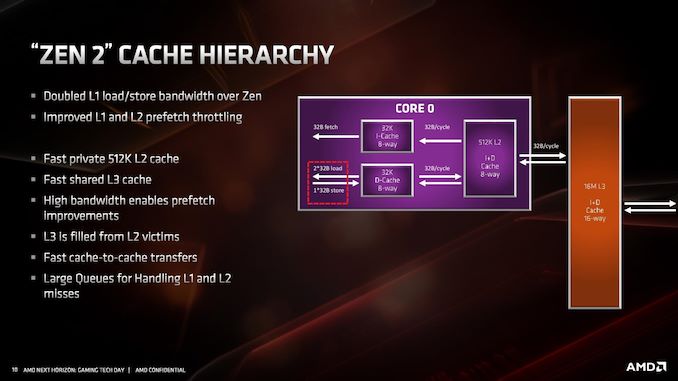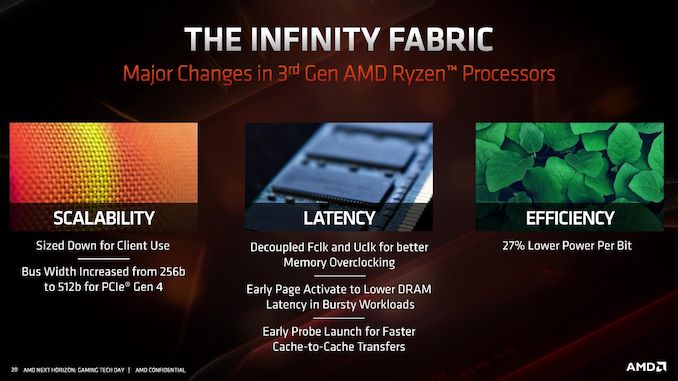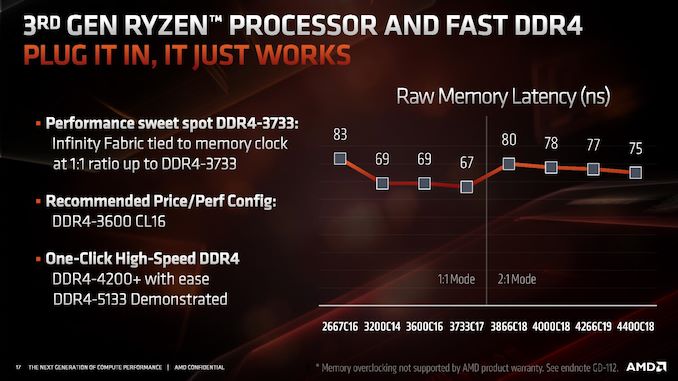AMD Zen 2 Microarchitecture Analysis: Ryzen 3000 and EPYC Rome
by Dr. Ian Cutress on June 10, 2019 7:22 PM EST- Posted in
- CPUs
- AMD
- Ryzen
- EPYC
- Infinity Fabric
- PCIe 4.0
- Zen 2
- Rome
- Ryzen 3000
- Ryzen 3rd Gen
Cache and Infinity Fabric
If it hasn’t been hammered in already, the big change in the cache is the L1 instruction cache which has been reduced from 64 KB to 32 KB, but the associativity has increased from 4-way to 8-way. This change enabled AMD to increase the size of the micro-op cache from 2K entry to 4K entry, and AMD felt that this gave a better performance balance with how modern workloads are evolving.
The L1-D cache is still 32KB 8-way, while the L2 cache is still 512KB 8-way. The L3 cache, which is a non-inclusive cache (compared to the L2 inclusive cache), has now doubled in size to 16 MB per core complex, up from 8 MB. AMD manages its L3 by sharing a 16MB block per CCX, rather than enabling access to any L3 from any core.
Because of the increase in size of the L3, latency has increased slightly. L1 is still 4-cycle, L2 is still 12-cycle, but L3 has increased from ~35 cycle to ~40 cycle (this is a characteristic of larger caches, they end up being slightly slower latency; it’s an interesting trade off to measure). AMD has stated that it has increased the size of the queues handling L1 and L2 misses, although hasn’t elaborated as to how big they now are.
Infinity Fabric
With the move to Zen 2, we also move to the second generation of Infinity Fabric. One of the major updates with IF2 is the support of PCIe 4.0, and thus the increase of the bus width from 256-bit to 512-bit.
Overall efficiency of IF2 has improved 27% according to AMD, leading to a lower power per bit. As we move to more IF links in EPYC, this will become very important as data is transferred from chiplet to IO die.
One of the features of IF2 is that the clock has been decoupled from the main DRAM clock. In Zen and Zen+, the IF frequency was coupled to the DRAM frequency, which led to some interesting scenarios where the memory could go a lot faster but the limitations in the IF meant that they were both limited by the lock-step nature of the clock. For Zen 2, AMD has introduced ratios to the IF2, enabling a 1:1 normal ratio or a 2:1 ratio that reduces the IF2 clock in half.
This ratio should automatically come into play around DDR4-3600 or DDR4-3800, but it does mean that IF2 clock does reduce in half, which has a knock on effect with respect to bandwidth. It should be noted that even if the DRAM frequency is high, having a slower IF frequency will likely limit the raw performance gain from that faster memory. AMD recommends keeping the ratio at a 1:1 around DDR4-3600, and instead optimizing sub-timings at that speed.













216 Comments
View All Comments
The_Assimilator - Wednesday, June 12, 2019 - link
The original version of this article noted the 3950X price wasn't confirmed at the time of publication, but it seems they edited that bit out after Su's presentation.Still need the table to be updated - PCIe and DDR4 columns at least.
vFunct - Tuesday, June 11, 2019 - link
Eventually these Multi-chip packages should incorporate system DRAM (via HBM) as well as SSD NVRAM and GPUs, and sold as full packages that you'd typically see in common configurations. 64GB memory + 1TB SSD + 16 CPU cores + whatever GPU.mode_13h - Tuesday, June 11, 2019 - link
GPUs are often upgraded more often than CPUs. And GPUs dissipate up to about 300 W, while desktop CPUs often around 100 W (except for Intel's Coffee Lake).So, it wouldn't really seem like CPUs and GPUs belong together, either from an upgrade or a cooling perspective. Consoles can make it work by virtue of being custom form factor and obviously you don't upgrade a console's GPU or CPU - you just buy a new console.
Therefore, I don't see this grand unification happening for performance-oriented desktops. That said, APUs will probably continue to get more powerful and perhaps occupy ever more of the laptop market.
Threska - Tuesday, June 11, 2019 - link
I imagine that's why there's PCIe 4.0 and now 5.0.R3MF - Tuesday, June 11, 2019 - link
memory support?3200 official, or higher...
SquarePeg - Tuesday, June 11, 2019 - link
According to AMD 3200mhz is officially supported but they (AMD) have had memory clocked to over 5000mhz. Infinity fabric will run 1:1 with up to 3733mhz ram but any higher and it splits to 2:1. AMD also said that they have found DDR4 3600 16-21-21 to be the best bang for buck on performance returns.R3MF - Wednesday, June 12, 2019 - link
cheersGastec - Wednesday, June 12, 2019 - link
But will those be 3200 MHz overclocked (XMP) or 3200 SPD?Cooe - Wednesday, June 12, 2019 - link
The latter. Only >3200MHz is now overclocked.Lord of the Bored - Tuesday, June 11, 2019 - link
That security slide, though...Most of a page of "N/A"
I love it.